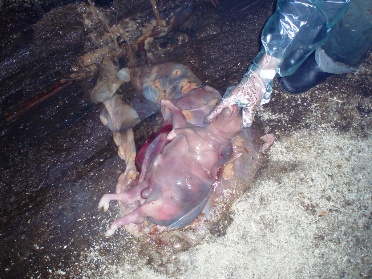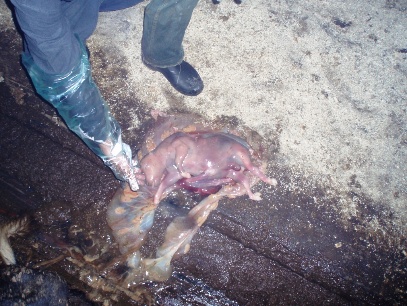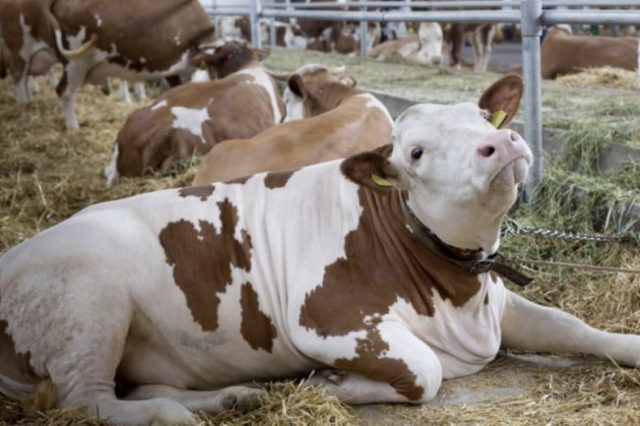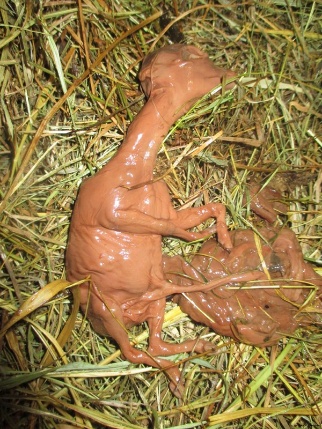Content
The difference between abortion and premature birth is that in the first case, the fetus always dies. The birth of a stillborn baby after the normal duration of pregnancy is not considered an abortion. Such a fetus is considered stillborn. The reasons for abortion are the same in all farm animals. A miscarriage in a cow is in this respect no different from an aborted fetus in a goat, sheep or pig.
Why the cow was aborted
The causes of abortion in cows range from being fed inappropriate feed to brucellosis, which is dangerous to humans. All types of miscarriages can be divided into 3 large groups: infectious, non-infectious and invasive. According to clinical signs, abortions are distinguished:
- full;
- incomplete;
- hidden;
- habitual.
Hidden abortion does not lead to miscarriage, and the owner of the cow often does not even suspect that this has happened. More often it is thought that the cow was dry during the first mating and it is necessary to cover it again.
Contagious causes of cow miscarriages
The number of infectious abortions includes invasive, that is, caused by parasites. Such miscarriages are not infectious, since the pattern of infection with parasites is different.
Infectious miscarriages cause:
- brucellosis;
- foot and mouth disease;
- listeriosis;
- pseudotuberculosis;
- tularemia (not always);
- rinderpest;
- infectious rhinotracheitis;
- viral diarrhea;
- respiratory syncytial infection of cattle;
- infectious catarrhal fever of sheep (sick and cattle) or "blue tongue".
Brucellosis is one of the most common infectious causes of abortion in cows. In some herds, miscarriages at 5-8 months occur in 50% of cows. Also, brucellosis is one of the main causes of abortion in heifers. Given that this disease is untreated, in a herd with annual introduction of heifers, miscarriages can occur for several years in a row.
Invasive abortion
They occur as a result of infection of a cow with parasites. In cows, only two types of parasites cause abortion: Babesia and Trichomonas. Babesia is carried by ticks, and the main peak of Babesiosis diseases occurs in the summer period. Since cows usually occur in March-April, as a result of infection with babesiosis, miscarriage occurs more often.
Trichomonas have different hosts and vectors. Infection with these parasites does not depend on the season. The carriers of the causative agent of cattle trichomoniasis are sire bulls. In a cow, the parasite is transmitted through sperm. With trichomoniasis, early latent abortions without miscarriages occur in the 1-3 month of pregnancy. After that, the cow comes back to hunt and aborts again. This gives the owner the impression that the cow is sterile.
Non-contagious causes of abortion
This group is divided into:
- alimentary;
- traumatic;
- idiopathic.
Miscarriage can also occur as a result of feeding feed oversaturated with mineral fertilizers. Often, cows are thrown off as a result of overexertion or fright. Abortions occur due to poisoning by poisonous plants, with the use of plant estrogens by cattle and with the use of uterine products.
Alimentary abortion
In essence, these are miscarriages as a result of food poisoning. A nutritional abortion in a cow can be caused by:
- sprouted or rotten potatoes;
- moldy hay;
- rancid concentrates;
- frozen root vegetables;
- sour silage;
- stillage with mustard seeds;
- fruits and plants of castor oil plant (very poisonous plant);
- juniper;
- nightshade;
- tansy;
- hemp;
- mustard;
- horsetail;
- rape.
Plant estrogens, which can cause miscarriages, are found in the maximum amount in herbs at the time of flowering. For this reason, it is undesirable for a pregnant cow to give flowering clover. Cows are also aborted because of the lack of essential amino acids, vitamins, complete proteins and minerals in the body.
Due to the active use of nitrogen fertilizers, even benign traditional cattle feed has become dangerous:
- peas;
- clover;
- alfalfa;
- rye;
- corn;
- roots;
- kale.
If the content of nitrates is more than 0.2-0.35% in the dry matter of the diet, pregnant cows are aborted.
Traumatic abortion
Traumatic miscarriages include:
- contusion of the abdominal wall;
- received a blow to the head;
- thermal and chemical effects;
- long-term transportation;
- stressful situation;
- too much physical activity.
If the injuries are small, their consequences may appear only after a few weeks, when the owner has already forgotten about the incident. In this case, the miscarriage will be a complete surprise and it may seem that the cow has thrown the calf out of the blue.
Traumatic abortion can occur as a result of a fight between two cows in a herd. In the video below, the miscarriage occurred as a result of steaming the peritoneum with the horns. The owner blames everything on the law that prohibits dehorning. In fact, a cow can throw off, even if the blow was inflicted by a lumpy rival. It's all about the force of the blow.
A stressful situation can also arise from scratch. As a result of explosions of firecrackers on New Year's Eve near the barn, many cows throw off from fear. If an animal has dropped a live calf, it is premature calving. Even if the calf died a couple of minutes after birth. At the birth of an already dead fetus, this is a miscarriage.
If the cow is forced to move too much and actively, miscarriage may occur within the next 1-2 days. This can happen if the herd is moved unwisely from one pasture to another, or if the herd is being chased by dogs.
Idiopathic abortion
A type of miscarriage, when the body of a cow gets rid of an unviable fetus. In veterinary medicine, idiopathic abortions are believed to be caused by nutritional causes or gamete deficiencies.
Similar miscarriages occur during development:
- fetal abnormalities;
- pathologies of the membranes;
- dropsy of the fetus or membranes.
Idiopathic abortion is possible even if the genotypes of the bull and cow are incompatible. In this case, 4 ways of pregnancy development are possible:
- latent abortion at an early stage;
- miscarriage due to pathology at a later stage;
- fetal death followed by mummification or maceration without miscarriage;
- the birth of a live calf with a deformity.
In the latter case, the cub usually does not live long, even if the owner tries to leave it.
Hidden abortion
The same as embryonic mortality. They can be caused by infectious diseases, trauma or genetic incompatibility. It differs from what is commonly called abortion in the absence of miscarriages. They are characterized by the death of embryos at an early stage of development. At the same time, the cow looks completely healthy. An external symptom is only repeated hunting 28-54 days after insemination.
The main causes of embryonic mortality are considered:
- fertilization abnormality caused by incompatibility of gametes during inbreeding;
- untimely insemination;
- incompatibility of proteins;
- chemical substances;
- vitamin deficiency E;
- immunological processes;
- inferiority of the function of the corpus luteum of the ovary;
- incompatibility of blood groups;
- the presence of cocci in the uterus.
The death of embryos most often occurs at critical moments in their development. One of these moments: implantation of the embryo and the formation of a placental connection. But such operations are carried out on large farms, implanting an embryo from a high-yielding donor to a low-yielding recipient. Such manipulations are not profitable for a private trader due to the complexity and high price.
Abortion without miscarriage
At a later date, the embryo can no longer dissolve on its own, but miscarriages do not always happen either. A dead embryo can remain in the uterus, and then two scenarios are possible: maceration and mummification.
Maceration
This is the name of the liquefaction of the soft tissues of a dead embryo under the influence of fermentation microbes. Maceration occurs in the middle of pregnancy. Softening of tissues is accompanied by inflammation of the endometrium of the uterus. The "freed" bones move and press on the cervix. Under pressure, the neck partially opens, and the bones come out along with liquid decomposed tissues. The color of the mucus coming out is gray-brown, the smell is pungent and sour.
During maceration, the cow shows signs of intoxication, loss of appetite and depression. When defecating from the vagina, first a foaming liquid is released, and then a mucous mass with pieces of bones.
The cow will be sterile as long as she has fetal remains in her uterus. Fertilization is possible only after cleaning the uterus and restoring the functions of the endometrium.
Mummification
Also occurs when the fetus dies in the middle of pregnancy. But in this case, there are no fermentation bacteria in the uterus, but there is a reduced contractility of the myometrium and a closed neck. Mummification occurs as a result of a violation of the reflex connection between the central nervous system and the neuro-reflex apparatus of the uterus.
If there is a mummy in the uterus, the cow cannot fertilize again. The corpus luteum is in a state of persistence. Hormonal activity is reduced. Observe:
- prolonged infertility;
- decrease in milk yield;
- loss of appetite;
- reduced water consumption.
Rectal examination reveals the absence of fluid in the pregnant horn and an enlarged diameter of the middle uterine arteries without "signs of life."
Treatment is carried out by removing the mummy. Since in the process of mummification and the further finding of the fetus in the uterus, dystrophic and inflammatory processes in the endometrium occur, reproductive abilities are not always restored.
Signs of an incipient miscarriage
In the early stages, if a hidden abortion has not occurred, then there are no signs of an impending miscarriage. The fetus is expelled from the uterus along with the membranes unexpectedly for the owner. If this happens in the pasture, abortion can even be skipped.
In later stages, the signs of an incipient abortion and normal calving are similar:
- decreased appetite;
- changes in the composition of milk;
- decrease in milk yield;
- udder swelling in non-lactating cows;
- anxiety;
- attempts;
- discharge from the vagina of cloudy bloody mucus.
The final stage of miscarriage is the expulsion of the embryo. In contrast to normal calving, miscarriage often results in retention of the placenta and inflammation of the uterus. In the cow, these two factors often lead to long-term infertility.
What to do if a cow has been aborted
The owner's response to a miscarriage depends on the situation. Veterinary instructions provide for the disposal of non-infectious corpses in special crematoria. But first you need to make sure that the miscarriage really did not occur as a result of an infectious disease.
The corpse of the calf, together with the placenta, is placed in a plastic bag until the arrival of the veterinarian. The place where the miscarriage occurred is thoroughly cleaned and disinfected. If possible, the uterus of the cow is cleaned of the remains of the placenta.A course of antibiotics of the penicillin group is injected into the cow to prevent inflammation of the uterus. The dosage, frequency of injections and the duration of the course depend on the type of antibiotic used.
All veterinary manipulations can be performed by a called veterinarian. Including prescribing an antibiotic. But in real life, more often than not, everything happens, as in the video below: the bedding after the miscarriage was cleaned out, the corpse of the calf was covered and later simply buried without research.
Methods of therapy for abortion in cattle
Abortion is not cured anywhere. What is lost cannot be revived. It is only possible to use antibiotics to prevent inflammation and prevent miscarriages before they occur.
The only option when there is a chance to prevent miscarriage is premature pushing. If a healthy cow starts pushing ahead of time, but the cervix has not yet fully opened, miscarriage can be prevented.
The signs of premature attempts are the same as at the hotel:
- the cow looks back at the belly;
- shifts from foot to foot;
- worried;
- often lies down and gets up.
Possible consequences
The consequences usually do not depend on the fact of a miscarriage. If there was a "natural" miscarriage of an unviable embryo due to genetic problems and there is no inflammation, then all the consequences are the need to have a cow with another bull again.
If abortion occurs due to health problems and abnormal pregnancy, the result can be life-long infertility. But more often than not, the cow needs to be seriously treated before attempting to do it again.
Preventive actions
Preventive measures depend on the type of abortion. With alimentary for the prevention of nitrate poisoning, solutions of glucose and ascorbic acid are used intravenously. The same is done when treating this type of miscarriage.
To avoid traumatic miscarriages, it is necessary to create comfortable living conditions for the cows. The floors should be anti-slip so that the pregnant animal cannot fall. It is necessary to exclude aggressive individuals from the herd that can damage the internal organs of other cows.
Prevention of idiopathic abortion is the correct selection of the parental couple. This is possible only with pedigree animals, the origin of which is known. In any other case, only the empirical path is possible.
In infectious abortions, the treatment and prevention of diseases is carried out, and not the miscarriages themselves. In case of mass abortions in the herd, an examination is carried out and the cause is eliminated. After that, the observance of sanitary norms for feeding and keeping pregnant cows and breeding bulls is monitored.
With embryonic mortality, only preventive measures are possible:
- observance of sanvetrequirements for insemination;
- insemination of a cow at the end of the hunt;
- injection of a solution of progesterone 1%;
- disinfection of the uterus with Lugol's solution 12 hours after insemination;
- feeding with vitamins and minerals.
In practice, in private households, few people carry out preventive measures.
Conclusion
A cow's miscarriage is a serious blow to the owner's budget, who counted on selling milk and a grown calf. But if in some cases it is really impossible to prevent abortion, then the prevention of infectious and invasive diseases is entirely in the hands of the owner of the cow. Scheduled vaccinations and regular deworming of the cow will significantly reduce the risk of miscarriage.












